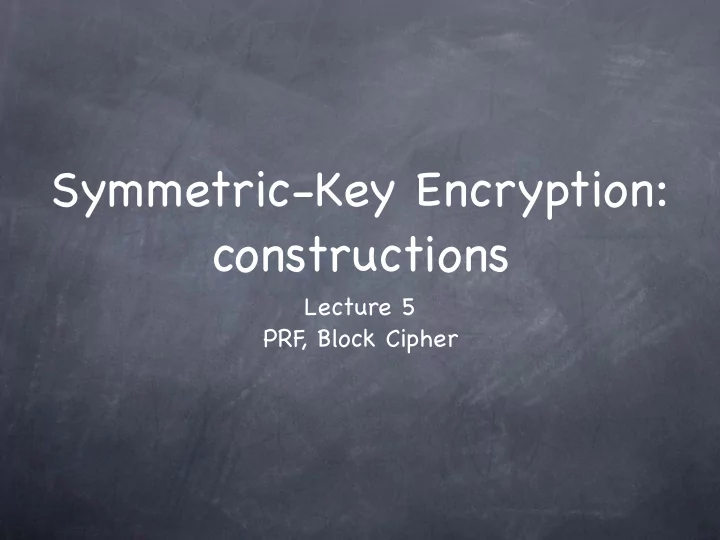

Symmetric-Key Encryption: constructions Lecture 5 PRF , Block Cipher
RECALL PRG m (stream) Enc G is a PRG if {G k (x)} x ← {0,1}k ≈ U n(k) and G PPT A PRG can be used to obtain a one-time SC PRG ⊕ K CPA-secure SKE Stream cipher: PRG without an a priori bound n(k) on the output length Security: The pad produced by the PRG is indistinguishable from a truly random pad Hence the scheme is indistinguishable from K SC PRG ⊕ the one-time pad scheme (which is one- time CPA secure) Question: Multiple-message SKE? Dec m
Beyond One-Time Need to make sure same part of the one-time pad is never reused Sender and receiver will need to maintain state and stay in sync (indicating how much of the pad has already been used) Or only sender maintains the index, but sends it to the receiver. Then receiver will need to run the stream- cipher to get to that index. A PRG with direct access to any part of the output stream? Pseudo Random Function (PRF)
Pseudorandom Function (PRF) A compact representation of an exponentially long (pseudorandom) string Allows “random-access” (instead of just sequential access) A function F(s;i) outputs the i th block of the pseudorandom string corresponding to seed s Exponentially many blocks (i.e., large domain for i) Pseudorandom Function Need to define pseudorandomness for a function (not a string)
Pseudorandom Function (PRF) F: {0,1} k × {0,1} m(k) → {0,1} n(k) is a PRF if all PPT F s adversaries have negligible advantage in MUX the PRF experiment R Adversary given oracle access to either F with a random seed, or a random function R: {0,1} m(k) → {0,1} n(k) . Needs to b guess which. b’ Note: Only 2 k seeds for F b ← {0,1} b’=b? But 2^(n2 m ) functions R Yes/No PRF stretches k bits to n2 m bits
Pseudorandom Function (PRF) A PRF can be constructed from any PRG K 000 G G is a K 00 K 001 length- G K 0 doubling K 010 PRG G K 01 K 011 G ... K K r K 100 G K 10 K 101 G K 1 K 110 G K 11 K 111 r
Pseudorandom Function (PRF) A PRF can be constructed from any PRG Not blazing fast Faster constructions based on specific number-theoretic computational complexity assumptions Fast heuristic constructions PRF in practice: Block Cipher K BC Extra features/requirements: r Permutation: input block (r) to output block Key can be used as an inversion trapdoor Pseudorandomness even with access to inversion
CPA-secure SKE with a Block Cipher Suppose Alice and Bob have shared a key (seed) m for a block-cipher (PRF) BC (block) Enc For each encryption, Alice will pick a fresh K BC pseudorandom pad, by picking a fresh value r and ⊕ setting pad=BC K (r) r Bob needs to be able to generate the same pad, so Alice sends r (in the clear, as part of the ciphertext) to Bob Even if Eve sees r, PRF security guarantees that BC K (r) is pseudorandom. (In fact, Eve could have K BC ⊕ picked r, as long as we ensure no r is reused.) How to pick a fresh r? Pick at random! Dec m
CPA-secure SKE with a Block Cipher How to encrypt a long message (multiple blocks)? Chop the message into blocks and independently encrypt each block as before? Works, but ciphertext size is double that of the plaintext (if |r| is one-block long) Extend output length of PRF (w/o increasing input length) input length r r sequential slightly decreased, r r,1 r,2 r,t based on ... F K F K F K F K F K F K an a priori ... limit on t Output is indistinguishable from t random blocks (even if input to F K known/chosen)
CPA-secure SKE with a Block Cipher Various “modes” of operation of a Block-cipher (i.e., encryption schemes using a block-cipher). All with one block overhead. Not a PRF (Why?) r Output Feedback (OFB) mode: Extend the r+1 r+2 r+t pseudorandom output using the first construction in the previous slide F K F K F K ... Counter (CTR) Mode: Similar idea as in the m 1 ⊕ m 2 ⊕ m t ⊕ second construction. No a priori limit on number of blocks in a message. Security from c 1 c 2 c t low likelihood of (r+1,...,r+t) running into m 1 m t m 2 r (r’+1,...,r’+t’) ⊕ ⊕ ⊕ Cipher Block Chaining (CBC) mode: ... F K F K F K Sequential encryption. Decryption uses F K-1 . Ciphertext an integral number of blocks. c 1 c 2 c t
Recommend
More recommend